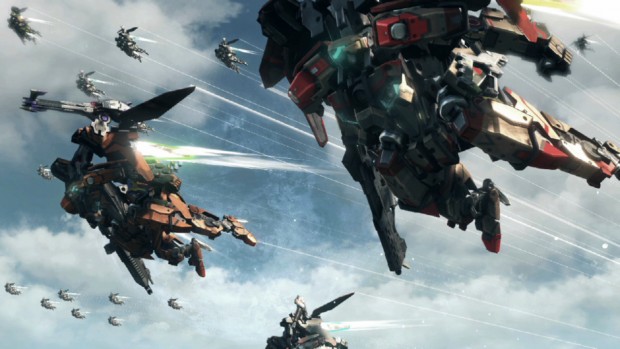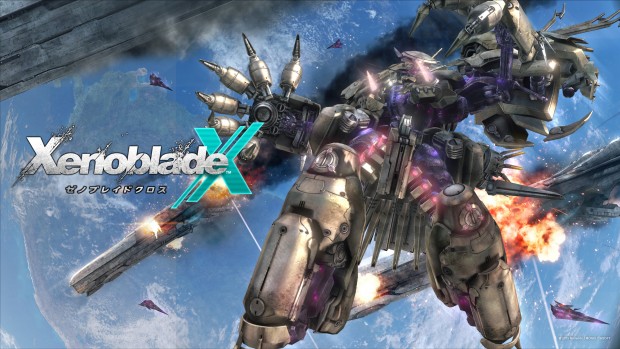


Xenoblade Chronicles X is a pretty different experience from its predecessor. Although the original Xenoblade Chronicles had plenty of side-quests and two massive continents to explore, its storyline was fairly linear, following a strict, straight path.
Xenoblade Chronicles X however, sticks to the modern concept of true open-world games. It’s a vast, open-ended adventure that allows the players to dictate the pace of the main story, the characters you meet, as well as the tons of things you can do in the game.
Of course, the huge world and all the possible exploration options can be intimidating at first, but as you progress in the game further, everything opens up to you more as you gain power and influence.
Besides, it’s not like exploration and disadvantage – on the contrary, as exploring the world is reward with new techniques, new weapons, and much more.
Weaponry
Weaponry in XCX is diverse. Surviving the harsh elements and indigens of Mira will require you to have the best gear for all your essential characters. The type of weapon a character can wield depends primarily on their class.
Different characters have different classes, and its usually best to equip your characters with vastly different weapons in-terms of function to increase diversity and capability to tackle all kinds of situations.
Depending on class, every character wields two weapons at all times: melee and ranged. Melee weapons are more powerful, generate more TP per attack, but they need you to be up close, which doesn’t work well against every enemy.
Ranged weapons give characters a bit of room to work, but their attacks don’t do much damage. Characters with ranged weapons also tend to aggro enemies more than melee ones, so don’t assume you’re safe by hanging back throughout a battle.
All weapons have various attributes, such as Attack (weapon’s power), required level, manufacturer, ammo consumption, stability, upgrades, TP Increase, stability, Attribute name, and Cooldown.
Armor
You could have the most bad-ass weapons in the world, but they’re useless if it only takes a sneeze to knock you out. That’s where Armor comes in. Armor affects all your personal stats and resistances, making survival a tad easier.
Armor is segmented in XCX, meaning that you get armor pieces that you put on. There are five areas where armor can be equipped: head, left arm, right arm, torso, and legs.
Some pieces of armor tend to take up more than one body part, and these often have much better stats than comparable ensembles.
Armor can be upgraded from the sub-menu, and can also be substitute ‘visually’ – if you don’t like how a powerful piece of armor looks, you can set it as a fashion gear, allowing you to dress however you want while keeping the stats you like.
Arts
As you progress in XCX, your characters will learn special abilities and attacks known as Arts. There are five types of Arts in the game.
You can find everything about various Arts in the Arts menu. Some Arts have added ‘conditions’ or special effects. For example, there are certain Arts that add TP if you attack an enemy from the front.
The Arts menu is especially useful in understanding what each Art does and how it functions. You can also upgrade Arts using battle points in the Arts menu.
Skills
Skills differ from Arts because they are mostly passive abilities. While Arts are cast in the battlefield, the effects of Skills activate automatically under the correct conditions when equipped.
You can view your party’s skills in the Skills menu.
Classes
Classes are designations that are applied to you and other party members. They dictate a number of characters. Essentially, classes are ‘specializations’ for your characters, and offer different battle roles and weaponry.
It is best to learn as many classes as possible, but making sure each party member specializes more in one class than the other. Such specialization allows you to have a diverse party that can tackle virtually every scenario thrown at you in the game.
As you go through the ranks of a class, you’ll unlock Arts and Skills, which you can then take on to the next class. You can view the classes tree in the Class menu.
If you reach the end of a tree and master the final class there, you can master its weapons. This means you’ll be able to use the weapons and the associated Arts in any class from then on.
Buffs and Debuffs
Buffs are positive effects granted to party members. Debuffs are the exact opposite – they are negative effects inflicted on one or multiple party members.
All buffs and debuffs in the game are temporary, and last for a specific amount of time. You can use various items and counter-buffs/debuffs to negate the effect if you wish.
Most buffs and debuffs are applied through Arts by your characters, and by specific abilities by enemies. However, there are quite a few ‘natural’ buffs and debuffs that are triggered by weather effects in the environment.
Combat HUD
Combat is initiated when your character(s) draw their weapons and advance towards the enemy.
At this time, it’s useful to understand the HUD. The on-screen displays are quite dense, but a quick glance with some knowledge should help you recognize everything pretty quickly.
On the left side of the screen is your characters’ display. It shows each character, their HP, Level, TP, Class Rank, Buffs, and Debuffs. That’s the easy and more obvious bit.
The rest of the stuff, located near the bottom of the screen, includes Morale Level, which shows your party’s solidarity. This determines how well your characters work together. The better the level, the more TP you gain, as well as getting more chances to activate Soul Voices.
Adjacent to the Morale Level is the Positional Relation. This shows your position in relation to the enemy. Attacking from the side or back against certain enemies has more advantages, so this is quite a useful display.
Below the Positional Relation is your currently equipped weapon. Right at the bottom of the screen, below Morale Level and Positional Relation are circular signs. These are your equipped Arts.
Battle Menu
You’ll often need to use items, or simply flee if a battle is too tough. Or, you could simply order your party members to follow specific tactics. For doing any of these tasks, you’ll have to access the Battle Menu.
Attacking
Your character will automatically attack an enemy once battle begins. These are basic auto-attacks, carried out periodically. The interval between two auto-attacks is determined by weapon stats.
While attacking, you can use the Positional Relation display to move about. Click your right stick during battle against certain enemies and aim for specific spots, such as appendages. Each appendage has its own HP and resistances.
Attacking weak appendages gives you benefits as your damage on the enemy increases for each appendage destroyed. You can also disable certain enemy Arts by destroying specific appendages, as well as gain special materials.
Your character will continue to auto-attack unless you command them to use an Art. Once an Art is used, a cool-down period takes place. During this period, you’ll be unable to use that Art again for a set time, which varies from Art to Art.
Once the cool-down timer has passed and the Art is usable again, a secondary cool-down is activated. This optional timer can be ignored, but if you wait it out, you’ll have access to more powerful versions of the Art.
Soul Voices and Soul Challenges
During battle, you and your party members will call out specific commands and tactics. You can respond to these calls by observing the color of the Soul Voice that is produced from them.
Activating an Art of the same color as the Soul Voice will successfully complete it, which can result in recovered HP, increased Affinity between all characters, increased Morale. Pages: 1 2




 Xenoblade Chronicles X Multiplayer Guide - Squads, BLADE Scouting, and More
Xenoblade Chronicles X Multiplayer Guide - Squads, BLADE Scouting, and More Xenoblade Chronicles X Skell License Exams Guide
Xenoblade Chronicles X Skell License Exams Guide Xenoblade Chronicles X Affinity Missions Guide - Pre-req, Party Members, Story
Xenoblade Chronicles X Affinity Missions Guide - Pre-req, Party Members, Story Xenoblade Chronicles X Soul Voices Guide - Best Dialogue Options and Tips
Xenoblade Chronicles X Soul Voices Guide - Best Dialogue Options and Tips Xenoblade Chronicles X Tips - Weapons, Armor, Combat, Skells
Xenoblade Chronicles X Tips - Weapons, Armor, Combat, Skells